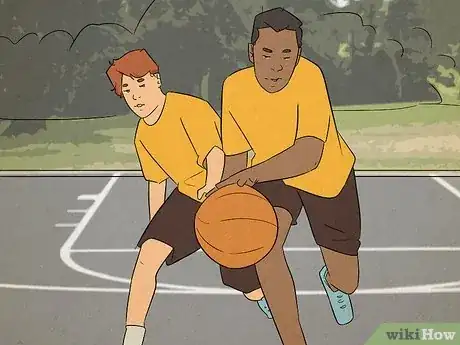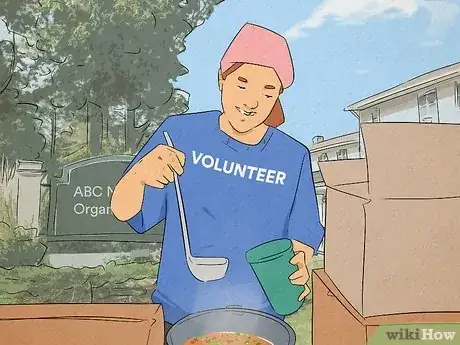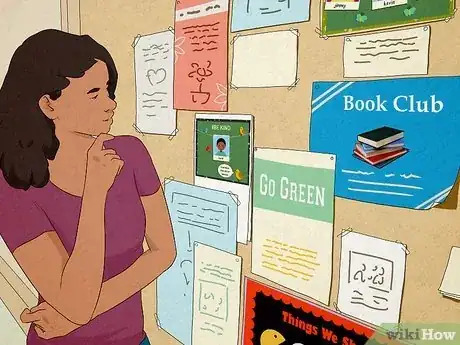This article was co-authored by Trudi Griffin, LPC, MS. Trudi Griffin is a Licensed Professional Counselor in Wisconsin specializing in Addictions and Mental Health. She provides therapy to people who struggle with addictions, mental health, and trauma in community health settings and private practice. She received her MS in Clinical Mental Health Counseling from Marquette University in 2011.
This article has been viewed 501,053 times.
Sure, alone time is great, but after a while, you'll probably want to spend time with other people. Even if you sometimes struggle to make new friends, we have the tips you need to spark up your social life.
Steps
Building Your Social Network
-
1Reconnect with old friends. Think about people who you know from the past, such as friends you made when you were in school or when you were working at a certain place. You may also have old friends from childhood or from when you used to be part of a club or group. Reach out to them so you can socialize.[1]
- For example, you may message an old friend and say, “I know it’s been awhile since we’ve talked but I would love to reconnect” or “Hello old friend, how are things?”
-
2Get to know your neighbors. Bring over cookies or tea to your neighbors as a way to introduce yourself. Focus on neighbors that you feel you might connect with, such as neighbors your age or that share your interests.[2]
- For example, you may knock on their door and say, “I baked some cookies earlier, would you like some?” or “I just wanted to introduce myself and say hello.”
Advertisement -
3Be friendly with people in your classes or at work. Connect with your peers in your classes, especially peers who sit next to you or near you. You can also be friendly towards people you work with as a way to grow your social network.[3]
- For example, you may say to your peer, “Have you started studying for the test?” or “How did you do on the exam?” as a way of starting a conversation with them.
- You can also say to people you work with, “How are your weekend?” or “How are your meetings going?” to be friendly and social.
-
4Meet online friends in real life. If you connect with people online, see if you can move these interactions into real life. Propose meeting in person for a coffee or a drink with people you chat with online on social media or in online groups.[4]
- For example, you may say to the person, “It’s been fun chatting with you online, want to meet up for a coffee?” or “I would love to continue our conversation over a drink.”
-
5Join a club at school or work. Meet new people and socialize by joining a school club, such as debate club, math league, or the drill team. You can also become a member of a group at work, such as the social events club or the company softball team.[5]
- You can also join a group outside of school or work, such as taking an arts class or joining a recreational sports league.
-
6Volunteer at local organizations. Pick an organization that you believe in and want to contribute to. Volunteer your time so you can meet other like minded people and bond with others while you help people.[6]
- For example, you may volunteer at your local soup kitchen or homeless shelter. You can also volunteer at a local music or arts festival.
-
7Participate in community events. Look for local groups in your community that can help you connect with new people based on shared interests. If you like reading, for example, you could join a book club. If you like exercise, you could join a running group. There are groups for almost any interest.
- Check flyers in local hangouts like coffee shops and site like Meetup.com to find groups or events in your area.
Talking to New People
-
1Greet the person in a friendly way. When you first meet someone new, begin the conversation by acknowledging them in a friendly, casual way so they know you want to engage with them. You may say "Hello" or "Hi," then introduce yourself. Ask them their name.
- A friendly, casual greeting might sound like, "Hey, my name's Mark. What's yours?"
-
2Memorize each person's name when you meet them. Try to remember their name so you can use it in your conversation with them. Repeat their name once or twice out loud to help yourself remember, and make sure you are pronouncing it correctly.
- You might say, "Frank Nguyen? Nice to meet you, Frank Nguyen."
- Ask them to repeat their name if you forget it, and apologize for forgetting.
-
3Demonstrate positive body language. Maintain eye contact when you greet the person. Keep your arms relaxed at your sides and turn your body towards them. You can also lean towards them. This will demonstrate that you are interested and engaged in the conversation.[7]
- You can also nod and smile to show the person you want to be social and connect with them.
- Relax the posture of your body. Sit or stand with your head up and your shoulders back to exhibit that you're open, friendly, and confident.
-
4Use small talk to get to know the person. Small talk is when you chat with the person about their life in an attempt to learn more about them. You can also share details about your life if they ask. To get the small talk started, you may ask the person about their profession and their schooling. You can also ask them how they know the host if you are talking at a party.[8]
- For example, you may say, “So, how do you know the host?” or “What brings you to the party?”
- You can also say, “What do you do for work?” or “Where did you go to school?”
- You can then answer any questions the person may have about your profession or schooling. This will keep the conversation going.
-
5Ask thoughtful follow up questions during the conversation. Follow up on information the person told you earlier in the conversation. Ask questions about something they told you. This will elevate the small talk to a more meaningful discussion.[9]
- For example, you may ask the person, “What’s it like to going to school in Japan?” or “What is it like to work in the field?”
-
6Focus on things you have in common. Pick up on interests you share with the person. This could be a favorite television show, a movie, or a book. Use things you have in common with the person to connect with them.[10]
- For example, you may say, “I watch that show, too. What was your favorite episode?” or “I just finished reading that book. What did you think of the ending?”
-
7Suggest doing something fun or interesting with the person. If you feel you and the person are connecting in a friendly way, you may suggest a hang out where you do something you are both interested in together. You can also invite the person to go out with your other friends or to spend time doing something you are planning to do in the near future.
- For example, you may say to the person, “I was actually going to see that author talk at a bookstore next week, care to go with me?” or “I was thinking of watching the next episode with some friends, care to join?”
Maintaining Your Social Life
-
1Make plans to see friends regularly. Schedule in time to connect with your friends, even if you feel you are always busy. Make time for your friends so you can maintain an active social life.[11]
- For example, you can try making regular coffee dates with a friend once a month on the same day so you can schedule around it. Or you may host game nights at your house with friends once a week so you all get to see each other.
-
2Say “yes” to invitations to hang out or socialize. Do not shy away from spending quality time with your friends. Be open to trying new things and socializing with friends regularly. Opt for saying “yes” rather than “no” to invitations to hang out.[12]
- You should also try to be on time and follow through if you agree to hang out with friends. Don’t be flaky or bail at the last minute unless you have a good reason.
-
3Be a good listener to your friends. Friendship is all about give and take. Being a good friend, and keeping your friends, means listening to them when they need it. Try to listen to your friends if they need someone to talk to. Be there for them emotionally when they need it.[13]
- You should also try not to judge your friends, as this can cause conflict in the relationship. Instead, listen and support them when they need it.
-
4Value high quality friends over having lots of friends. Making good friends and maintaining a healthy social life takes time. Connecting to a lot of people may be challenging. Instead, focus on making one or two friends that you like and appreciate, or find a small group of people that you connect with on a deeper level.
References
- ↑ https://www.succeedsocially.com/sociallife
- ↑ https://www.succeedsocially.com/sociallife
- ↑ https://www.succeedsocially.com/sociallife
- ↑ https://www.succeedsocially.com/sociallife
- ↑ https://www.succeedsocially.com/sociallife
- ↑ https://www.succeedsocially.com/sociallife
- ↑ https://www.inc.com/peter-economy/18-ways-to-make-your-body-talk-the-language-of-success.html
- ↑ https://englishwithkim.com/introductions-and-making-small-talk/
- ↑ https://www.nerdfitness.com/blog/the-4-step-plan-to-not-suck-at-talking-to-people/
About This Article
If you are craving more of a social life but are feeling nervous about making new friends, start by building your social network with people you already know. Think about people who you know from the past, like friends you made in school or at jobs, and try reaching out to them. For example, you might message an old friend and say “I know it’s been a while since we’ve talked, but I would love to reconnect.” You can also work on getting to know your neighbors by bringing over cookies or tea and introducing yourself. If you’re currently in school or have a job where you work with people your own age, try striking up conversations about a recent test or meeting to build a friendship. Another way to broaden your social network is to join a club, volunteer, or participate in community events. To learn how to get to know new people, keep reading!













































































